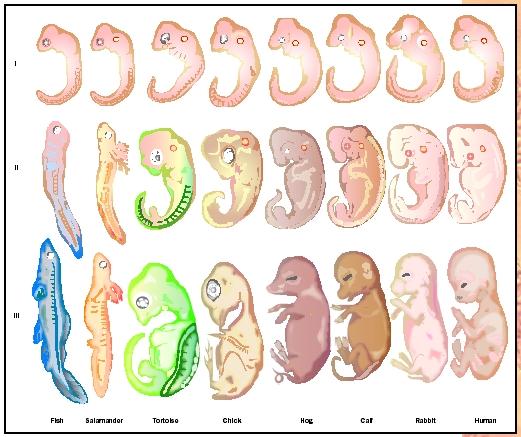 |
| The Tiktaalik Roseae |
Paleontology
A person who studies prehistoric life is called a Paleontologist. One fossil that paleontologists were trying to find was the creature that filled the gap between fish and land vertebrae, or a transitional fossil.The paleontologists working on this project were E. Daeschler, N. Shublin, and F. Jenkins. What they found was a large fish, that had both characteristics of a land vertebrae and a fish. They named it the Tiktaalik (Tiktaalik means large, fresh water fish.) The Tiktaalik is a tetrapod, meaning it has four limbs. It is similar to a land vertebrae in that it has ear notches, fin skeletons, it's flat head, it's ribs, and it's neck. It is similar to a fish in it's scales, fins, and gills. From the placement of the Tiktaalik in the earth, paleontologists have determined that it roamed the earth 375 years ago. You can use Paleontology to prove evolution by showing how the bones themselves evolved.
Biochemistry
How does Biochemistry provide evidence for Evolution? When you compare amino acid sequences with humans and animals, the data shows only a couple of differences in. Data from amino acid sequences generally agree with the anatomical data that can be used to make a cladogram. Organisms with fewer shared anatomical traits also have more amino acid differences. A "human-monkey" relationship is a closer relationship compared to a "duck-chicken" relationship, proven by the molecular data. We can be fairly confident that the amino acid pattern is accurate because the molecular data, the structural similarities and the fossil record all support the same pattern of relationships. Chicken and turkeys are both birds and have the same sequence of amino acids in their cytochrome-c protein because they both came from the same common ancestor.
 |
| Cladogram |
Embryology
How does Embryology provide evidence for evolution? Well, Embryology shows that a lot of different species are formed in similar ways. Phylogeny is the relatedness of species through a descent of a common ancestor. The early development stages of all vertebrates are similar because apparently, they all came from the same animal. Embryos all follow similar development courses because they came from the same animal. Some other evidence I have examined that indicates similar genes at work in organisms is that different people may have the same facial features and behavior pattern.
 |
| Embryological envelopment |
Anatomy
How does anatomy provide evidence for Evolution? The functions of the limbs of each of the animals is illustrated differently. The bones of the limbs are arranged in a somewhat similar way in each animal. The similarity in bone structure suggests a common ancestor among the animals. Butterfly wings and bird wings both share the function to fly. The structures differ in sizes and bone placement. They are considered analogous structures because they're similar. Eye sight isn't an important adaptation to life in the deep sea cave because they can't see down there in the first place! The cave fish and the minnow do suggest a common ancestor because they look very similar. There is no evolutionary relationship between the fin of a fish and the flipper of a whale because they are analogous structures having the same basic function, but totally different structures, therefore, it is not a homologous structures. Another example of a vestigial would be the muscles attached to the ear because they aren't present in a monkey's ear.
 |
| The anatomy of a whale |
Subscribe to:
Posts (Atom)
